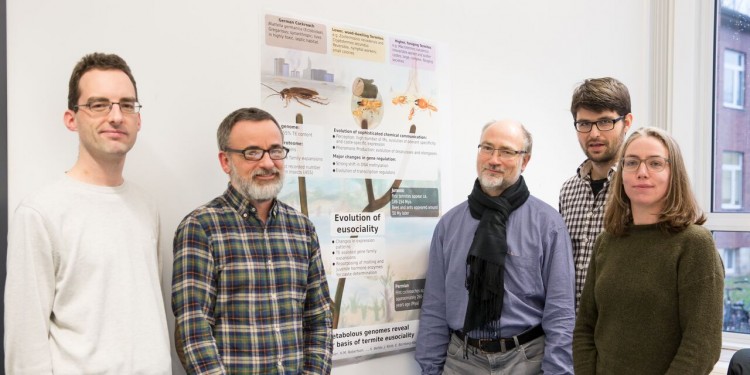
Scientists investigate the molecular basis of social evolution in Termites
One phenomenon that fascinated Charles Darwin and many other researchers since is the emergence of huge, complex insect societies. Even more fascinating is that the societies of termites and ants evolved independently from each other. Although unrelated, termites and ants are very similar: They both have a so-called “eusocial” way of living. This includes distinctive features such as the creation of reproductive castes (queens and workers) or a complex system of division of labour among workers. These castes also include morphologically very different workers and soldiers. However, termites and ants are not closely related. While termites first emerged around 150 million years ago from the cockroaches, ants and other eusocial Hymenoptera (e.g. bees and wasps) appeared 50 million years later on a very distant branch of the insect family tree. A researcher group headed by bioinformatician Prof Erich Bornberg-Bauer at the Institute for Evolution and Biodiversity at the University of Münster have now compared the molecular basis for the evolution of eusociality within both groups for the first time. The study has been published in the scientific journal Nature Ecology and Evolution.
All the important information for the blueprint and behaviour of an organism is contained in its genome. By comparing genomes, valuable information can be obtained to help explain how millions of years of evolution have generated remarkably complex organisms. In this way the researchers uncovered distinctive genetic features in the genomic regions which encode chemoreceptors, i.e. the proteins involved in chemical communication.
“Compared to the closely related cockroaches, the involved protein families are strongly reduced but at the same time strongly diverged in their function, underlining their importance,” Erich Bornberg-Bauer points out. Chemical communication via pheromones enables members of insect societies to, for example, recognise nest mates and differentiate between castes. This form of communication is vital for the colony life of these animals.
On the surface, these results are surprisingly similar to findings from previous studies on the evolution of eusociality in bees and ants. However, further analyses by Bornberg-Bauer and colleagues revealed that in termites a related but clearly distinct family of chemoreceptors unlike those in ants and bees had been specialised for the recognition of pheromones. “This is, therefore, a classic case of convergent evolution: Both groups evolved similar molecular mechanisms for a eusocial lifestyle under similar selection pressures,” says genomics expert Dr Mark Harrison, first author of the study. The scientists found evidence for further convergences, including genes that play a role in the synthesis of hydrocarbons in the cuticle, the hard shell of insects. These cuticular hydrocarbons play an important role in communication as they contribute to a distinctive blend of aromas that have been linked to colony, caste and reproductive status.
In this study the researchers sequenced the first genome of a cockroach (German cockroach, Blattella germanica) and a drywood termite (Cryptotermes secundus). They compared the genomes, the genetic activity and the complete set of proteins (proteome) of three termite species with those of the cockroach. Moreover, they compared the results with corresponding data from 16 other insect species, including several ant species. With the help of specialised algorithms, they reconstructed the genetic configuration of the ancestors of today’s termites. In this way they were able to retrace the appearance of random mutations that enabled the evolution of eusociality.
Prof Bornberg-Bauer and his team discovered that transposons were one of the most important causes of the genomic changes that supported these molecular adaptations. Transposons are DNA regions that possess the ability to duplicate and change position within a genome. “We were able to deduce that, long before the evolution of termites, one particular class of transposons led to the expansion of gene families involved in communication,” added Dr Evelien Jongepier, also first author. These protein expansions have led to the cockroach possessing possibly the largest so far recorded insect proteome, creating a high adaptation potential. These large protein families have then adapted towards a more sophisticated communication system, thus enabling the evolution of eusociality.
Scientists from eleven research institutions in six countries participated in the study, including researchers from the University of Freiburg, the University Pompeu Fabra in Barcelona, the University of Illinois at Urbana-Champaign, North Carolina State University, and scientists at the Baylor College of Medicine Human Genome Sequencing Center in Houston as part of the i5k project. The Münster scientists received financing through a grant from the German Research Foundation (DFG).
Eusociality
Scientists distinguish between different types of cohabitation and the formation of societies in the animal kingdom. The most complex form is “eusociality”, which comprises the coexistence of several generations within a single colony, cooperative brood care and the reproductive division of labour. This means that only one or a few individuals within a colony reproduce, for example, the queen and king termites, while other individuals are infertile.
Original article:
Harrison M. C., Jongepier E., Robertson H. M. et al. (2018): Hemimetabolous genomes reveal molecular basis of termite eusociality; Nature Ecology and Evolution (Advance Online Publication), doi: 10.1038/s41559-017-0459-1
